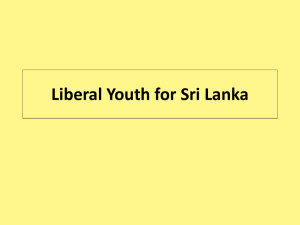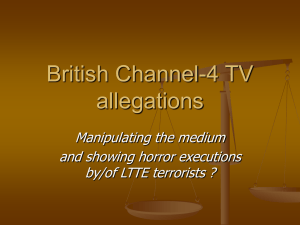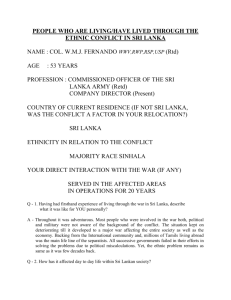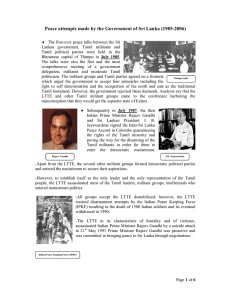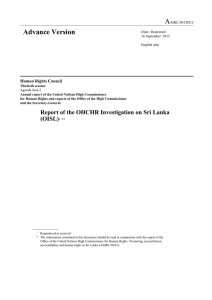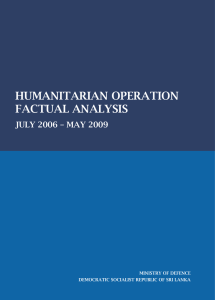Democratisation and Conflict Transformation
advertisement
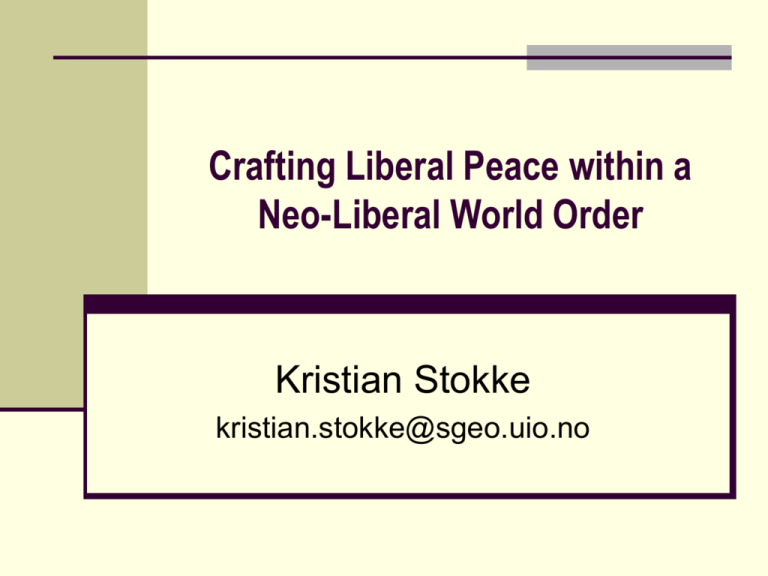
Crafting Liberal Peace within a Neo-Liberal World Order Kristian Stokke kristian.stokke@sgeo.uio.no Conflict in the ’New World Order’ National/territorial economies and polities within a structure of geopolitical rivalry between Western capitalism and East Bloc socialism Hegemonic liberal world order. Transnational networks yield new forms of inclusion and exclusion of places, sectors and groups New conflicts: Interstate wars (inscribed in Cold War rivalry) replaced by intrastate wars at the periphery of the liberal world order Merging of Development and Security Although development aid has been used geopolitically earlier, development and security were seen and organised as separate spheres. This changed after the end of the Cold War Conflict as a development problem ”New wars” (intrastate wars) pose obstacles to successful development processes. Crafting of peace as a way to promote aid effectiveness Underdevelopment as a global security problem Threat of an excluded Global South generating international instability through transnational migration, spread of conflicts, criminal networks and international terrorism. ”Underdevelopment has become dangerous” (Mark Duffield) Securitisation of aid Peacebuilding UN Secretary General Boutros Boutros Ghali’s 1992 report to the Security Council (Agenda for Peace) presented peacebuilding as an important addition to UN efforts at peacekeeping and peacemaking. While peacekeeping implies containment of armed conflict (conflict management), peacemaking means diplomatic actions to bring hostile parties to a peace agreement (conflict resolution). Peacebuilding refers to a much broader process of supporting peace, especially through social and economic development (conflict transformation). Peacebuilding was initially conceptualised as post-conflict development interventions to prevent the recurrence of violence after a peace agreement, but the term has later been broadened to include peacesupporting initiatives before and during a violent conflict. Now peacebuilding is seen as interventions aimed at preventing the outbreak, the recurrence or the continuation of armed conflicts. Conflict as development problem “War retards development, but conversely, development retards war. This double causation gives rise to virtuous and vicious circles. Where development succeeds, countries become progressively safer from violent conflict, making subsequent development easier. Where development fails, countries are at high risk of becoming caught in a conflict trap in which war wrecks the economy and increases the risk of further war” World Bank 2003, Breaking the Conflict Trap Securitisation of aid Working around, in and on conflict Multilateral agencies and major donor nations are increasingly concerned with crafting transitions from war to peace in order to mainstream ‘post-conflict’ development. Development aid has undergone a partial shift from ‘working around conflict’ (i.e. providing development aid without taking conflicts into account), through ‘working in conflict’ (i.e. offering humanitarian relief and development aid in a conflict-sensitive manner), to ‘working on conflict’ (i.e. providing development assistance towards reducing and managing conflicts). Strategic complexes of actors Wile states and governments remain important, and will continue to do so, they exercise their authority through complex international, national and subnational governance networks linking state and non-state actors. State actors Non-governmental organisations Military establishments Commercial sector Multilateral and regional organisations Need for and emphasis on coordination! Crafting Peace All of this points to a new emphasis on crafting peace through development, with a prominent place of global strategic complexes in international development But what kind of peace is sought? And what is the underlying conceptualisation of peace? The answer: Liberal Peace Roland Paris (2004): At war’s end: Building peace after civil conflict Liberal Peace The liberal peace thesis: democratic governments are more peaceful – both in internal politics and in international relations – than other forms of government. Kofi Annan (2000): ”Democracy is a highly effective means of preventing conflict, both within and between states” Make the world safe for and through liberal democracy. This ’Wilsonian’ remedy (after Woodrow Wilson) was first applied in international relations after World War I but has been rearticulated in the post-Cold War period Counterpoint (Roland Paris): While the liberal peace thesis may hold true for established liberal democracies, transformations into liberal market democracies may have a much more complex relationship with conflict. Therefore; ”Any careful analysis of peace-through-liberalization policies must consider both the end result of a successful transition to market democracy and the effects of the transition itself.” Liberal democracy/Neo-liberal development Despite lack of central coordination, a remarkable convergence across peacebuilding operation around marketisation and democratisation Constructing liberal democracy Promoting economic liberalisation Promoting and administering Encouraging the development of democratic elections Promoting civil and political rights. Drafting national constitutions that codify civil and political rights Promoting law and order. Training police and justice officials Promoting power-sharing and territorial reorganisation of state power Promoting’civil society’ free-market economies, stimulate growth of private enterprise Reducing the role of the state, supporting the development of neoliberal governance Key features of both transitions Elite-negotiated transitions supported by international actors Rapid deployment of reforms Norway as a peace nation The ”Peace Nation”: Norway has acquired a new role in international relations as facilitator for peace processes (e.g. Middle East, Sri Lanka, The Phillippines, Guatemala, Colombia, Sudan …). Started in the Middle East and might end with Sri Lanka ??? Preconditions: Foreign policy legacy with a taken-for-granted placement of Norway within the US-dominated bloc, combined with a strong tradition for international humanitarian involvement, solidarity and development aid. Norway’s justification and strategic interests: solidarity and humanism, but also recognition and influence in international arenas. The construction of Norway as a ’peace nation’ serves strategic interests within the contemporary world order The Norwegian model: provide ”good offices” for peace negotiations (facilitator), support for peacekeeping through UN and other organisations (monitor), use of development cooperation to support peacebuilding (donor), governance of international security/ development complexes also including Norwegian NGOs (coordinator) Implication: Peace facilitation that depends on the power constellations of stakeholders within a conflict and among the international actors ”The Peace Nation” Norway has acquired a new role in international relations as facilitator for peace processes (e.g. Middle East, Sri Lanka, The Phillippines, Guatemala, Colombia, Sudan …) This new role is increasingly linked to old roles as donor (and peacekeeper). Instrumental use of development assistance in support of peace Norway’s justification and strategic interests: solidarity and humanism, but also recognition and influence in international arenas. The construction of Norway as a ’peace nation’ serves strategic interests within the contemporary world order The Sri Lankan ’Ethnic’ Conflict Sinhalese Nationalism Tamil Nationalism The Nation • Sinhala Buddhist people The Nation • Tamil-speaking people National Homeland • Dhamma Dipa National Homeland • Tamil Eelam The Nation-State • Pre-colonial Kingdoms The Nation-State • Pre-colonial Jaffna Kingdom National Oppression • Domination by foreigners National Oppression • Post-colonial oppression Post-colonial Nationalism • To reconstruct the nationstate and rectify injustices • Unitary state Post-colonial Nationalism • Self-determination for security and justice • Federal/separate state Multiethnic class politics Late colonial and early post-colonial period Politicisation of ethnicity Political mobilisation of middle and lower middle classes by way of majoritarian democratic socialism and minority nationalism. Social/political exclusion and resistance Economic crises yielding social and political exclusion, leading to resistance that mobilise around already politicised ethnic identities Preconditions for the 5th peace process Military-territorial balance of power Territorial balance of power: Eelam War III ended in a mutually hurting stalemate with a certain territorial balance of power between GOSL and LTTE. This territorial balance was frozen through the 2002 CFA and became the basis for a complex ”war by other means”, including LTTE’s strategy of institutionalising power sharing and building a de facto state Geographical fixation: Territorial balance of power between the protagonists as the basis for the peace process and also the main contentious issue in the process. Incompatible territorial agendas of rebuilding the unitary state (GOSL) and constructing a separate state (LTTE) replaced by an agreement to explore a federal solution Preconditions for the 5th peace process Development crises and aid effectiveness Government of Sri Lanka: High developmental costs of war (likely to yield electoral losses), convergence of interests between the UNFgovernment and the business community (as well as peace-oriented civil society), promises of economic (and political) peace dividends Liberation Tigers of Tamil Eelam: Destroyed lives and livelihoods in war-affected areas, promises of humanitarian relief and reconstruction as well as material and political benefits for LTTE International aid donors: Increased attention to aid effectiveness, war understood as a cost to development and peace as an prerequisite for governance and development. Sri Lanka also placed (to a certain extent) within the emerging discourses on new wars/new security concerns in Western donor countries Preconditions for the 5th peace process Political obstacles to peace Dual state structure with political obstacles to peace within two political entities The Sri Lankan state formation: A majoritarian formal democracy within a unitary and centralised state, with extensive concentration of power and relatively weak de facto checks on the powers of the executive government. The stakes in the field of politics have become very high, contributing to political fragmentation and intense intra-elite rivalry. A proportional representation system returning weak majority governments with limited chances for needed constitutional reforms amidst political fragmentation and instrumental opposition to peace The LTTE pseudo-state: LTTE has demonstrated an ability to construct state institutions and to govern areas under their control, but doing so by way of authoritarian centralisation with few mechanisms for democratic representation Dual challenge of transforming political institutions and practices in the direction of substantive devolution of power and substantive democracy. These challenges are inseparable: electoral democracy without devolution (rebuilding the unitary state) or devolution without democracy (constructing an authoritarian local state) will not yield a just and lasting peace. However, the protagonists did not have the capacity/mandate or willingness to engage directly with these core political issues Characteristics of the 5th peace process Internationalisation of peace International actors in multiple roles: facilitators (Norway), monitors (Nordic countries) and donors (EU, USA, Japan, Norway, multilateral and regional development agencies, international humanitarian and development NGOs) Capacity and space of different actors defined by (1) the balance of power between and within the two parties to the conflict as well as the wider political dynamics in Sri Lanka; and (2) the power constellations and interests among the international actors Pragmatic design of peace process: ’politics of the possible’ as a source of both success and failure Characteristics of the 5th peace process Narrow definitions of issues and stakeholders Exclusion of stakeholders: Formal negotiations between the LTTE and the GOSL combined with consultations with other stakeholders (including the Sri Lankan President, Government of India, civil society organisations etc.). No institutionalised arenas for participation by other stakeholders (e.g. the Muslim minority or the Tamil and Sinhalese opposition) Exclusion of issues: Negotiations focusing on humanitarian/development issues and the question of territorial power-sharing (CFA/federalism), postponing political ‘core issues’ of human rights, democracy and governance This exclusion of stakeholders from the peace process (in the context of political fragmentation and intense political rivalry) produced a number of potential ’spoilers’ within the political elite Characteristics of the 5th peace process Normalising neo-liberal development Development as a forerunner for peace: Convergence around humanitarian needs and rehabilitation as a trustbuilding precursor to negotiations over core issues. Little discussion about what kind of development, but convergence around a technocratic and neo-liberal approach to development Social exclusion: This development model ran counter to the interests of key electoral constituencies that have traditionally been politically incorporated through a combination of material concessions (public sector employment/welfareism/patronage) and symbolic representation (populist ethnonationalist rhetoric). Internationally sponsored neo-liberal development furthering uneven development provided a social basis for oppositional mobilisation against Westernised liberal peace and development Characteristics of the 5th peace process Securitisation of aid, problematic strategic links State security and the peace conditionality: demands for progress in the peace process as a precondition for development assistance. However, aid has not been linked to concrete reforms and not worked out in collaboration with GOSL/LTTE. Two decades of aid conditionalities show that this approach is unlikely to succeed. ”Money cannot buy peace in Sri Lanka”. The political costs of peace for the majority political elite is higher than the costs of conditionalities Human security and NGOs: Humanitarian and development assistance increasingly channeled through international NGOs (in absence of joint mechanisms). This has supported recovery and reconstruction, but have had limited political impacts International pressure and aid remains important, but may be more effective if it is tied to specific political reforms (e.g. promotion of human rights, good governance, decentralisation, electoral reforms etc). Demands for transformations unevenly applied, especially with escalation of hostilities. International actors tilting the balance of power in favor of GOSL (e.g. EU terrorlisting LTTE) Characteristics of the 5th peace process Politicisation of development administration Absence of shared framework for peace: In absence of a joint ’road map’ for peace (core issues), every pragmatic step was politicised as both sides tried, or were seen as trying, to tilt the balance of power in their favor. LTTE accused GOSL for seeking to rebuild/relegitimise the unitary state. GOSL/opposition saw LTTE’s ISGA plan as a first step towards secession. Divisive politicisation of development administration: Rather than depoliticising the conflict, the focus on development created a stalemate over institutional arrangements for joint development administration. Post-tsunami: Experiences with SIHRN/ISGA repeated through P- TOMS Sri Lanka after the tsunami Humanitarian pause followed by war From complex emergency to peace? Local relief assistance across ethnic cleavages, but also politicisation of humanitarian assistance Donor concerns with aid effectiveness: demands for a joint mechanism to ensure efficient delivery of relief (revitalised peace process a possible side effect) Politicisation of aid administration: P-TOMS agreement ready to be signed in February 2005. Oppositional politicisation around questions of state sovereignty and power-sharing. P-TOMS signed in June 2005, but put on hold by Court order and by the new government The political effect of the tsunami: The tsunami furthered pre-existing political dynamics rather than a fresh impetus for peace. Humanitarian pause from the on-going escalation of hostilities. After the tsunami the resumption of warfare seems to have been delayed by approximately one year. Politics around P-TOMS as a replay of the 5th peace process. Draws attention to this process and how it compares to Aceh Lessons from Sri Lanka’s 5th peace process Main points on Sri Lankan case Constellations of power producing a peace process with distinct characteristics: Pragmatism yielding exclusion of political stakeholders and issues Internationalised securitisation of aid, but weak strategic links to political transformations Neoliberal rehabilitation and development furthering uneven development and social exclusion Combination of political and social exclusion producing a significant opposition political force. Politicisation of state sovereignty in the face of Westernisation and proposals for power-sharing (development administration/federalism)
